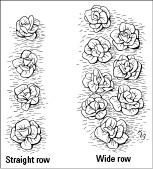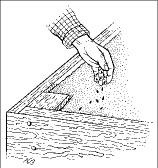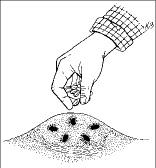Vegetable Gardening (93 page)

 Immediately before planting seeds, loosen your garden soil with a hoe or shovel to a depth of 6 inches.
Immediately before planting seeds, loosen your garden soil with a hoe or shovel to a depth of 6 inches.
Rake over the area to create a smooth planting surface. Don't walk over areas where you'll be sowing seeds; stay in the pathways. Compacting the soil makes it difficult for seedlings to emerge and send down their roots.
 Sow seeds at the proper planting depth.
Sow seeds at the proper planting depth.
A seed planted too deeply uses up its supply of stored nutrients before the seedling can push its way to the surface; a seed planted too shallow may dry out. A general rule is to plant seeds to depths that are two to three times their diameters, but the appendix gives recommended planting depths for different kinds of seeds. Also try to sow at a uniform depth because seedlings are more likely to emerge at the same time, enabling you to see where your plants are when you do your first weeding.

 Water newly planted seeds carefully.
Water newly planted seeds carefully.
Use a watering can with a rose (nozzle with multiple holes) or a hose with a
breaker attachment
(a nozzle that breaks the stream into a gentle spray). A strong stream of water can wash seeds out of a bed or too deeply into the ground. Keep the seeds moist but not soggy until the seeds germinate. Heavy soils often form a crust as they dry out, making it difficult for the seedlings to break through. A moist surface helps prevent crusting, as does covering seeds with vermiculite or sand, instead of soil alone. If the weather is dry after you sow the seeds, gently water the seeded area every 2 days or so.
The following sections explain the basic methods for planting your seeds.
Row planting
The first step when row planting is to mark the placement of a row within your garden. A planting line consisting of a simple string and stakes enables you to easily lay out rows. Make a
furrow,
or trench, at the correct depth along the row. To make a shallow furrow, lay a rake or hoe underneath your string marker, and press the handle into the soil. You can make deeper furrows (ones that can be used for watering, too) by dragging the corner of your hoe across the soil surface, using the string as your guideline.
Sow seeds more thickly than you want the final spacing of the crops to be to ensure an adequate number of plants; some seeds may fail to sprout. Thinning rows is less of a chore if you space seeds as evenly as possible. Large seeds like peas and beans are easy to space at precise intervals, but evenly spacing small seeds can be a real challenge.
Cover the seeds with fine soil and then firm them in with the back of a hoe to make sure that all the seeds are in contact with the soil. Water gently.
 If you're planting long rows of corn, beans, or peas that will be furrow-irrigated (see Chapter 15), fill the furrows with water first and then push the large seeds into the top of raised beds.
If you're planting long rows of corn, beans, or peas that will be furrow-irrigated (see Chapter 15), fill the furrows with water first and then push the large seeds into the top of raised beds.
Wide row planting
You can plant more seeds in less space and get higher yields by using the wide row planting method. (Figure 13-4 compares wide rows and straight single rows.) This method not only saves space but also allows you to concentrate watering, weeding, and fertilizing in a smaller area. Follow these steps for wide row planting:
1. Choose the location and width of your row, usually 10 to 16 inches wide, and then smooth the soil until it's level.
You may want to run strings along the outside edges of the row to clearly designate the planting area.
2. Sprinkle seeds over the entire row — with most crops, try to land the seeds about 1/2 to 1 inch apart (for peas and beans, 1 1/2 to 2 inches).
Pat the seeds down with the back of a hoe.
3. Use a rake to lift soil from the side of the row to cover the seeds, and gently smooth the soil covering the seeds to the same depth throughout the row.
With small seeds like carrots and lettuce, cover the seeds with a thin layer of potting soil. Then pat the potting soil down again to bring the added soil into firm contact with the seeds.
4. Water the seeds gently.
Keep the soil moist by gently watering a few times a week or when you see that the top layer of soil is drying out.
Figure 13-4:
Straight single rows versus wide rows.
Raised bed planting
Planting raised beds is essentially the same as planting wide rows. To prepare your beds, see Chapter 14. If you don't have permanent beds, mark the dimensions and smooth out the soil. You can broadcast sow (sprinkle by hand) in single rows with a few inches between rows, as shown in Figure 13-5, or you can plant individual seeds at the proper distance apart.
Figure 13-5:
Broadcasting seeds in a raised bed.
Hill planting
Plant seeds for vining crops that spread out — such as squash, melons, or cucumbers — in hills or circular groups, as shown in Figure 13-6. Loosen and level the soil in a 1-foot-diameter area, and then plant five to six seeds close together. After the second set of true leaves form, keep the two strongest seedlings (the ones that are the biggest and sport the most leaves) and thin out the remaining seedlings by cutting them with scissors (see the next section for details).
Figure 13-6:
Sow vining crop seeds in hills.



